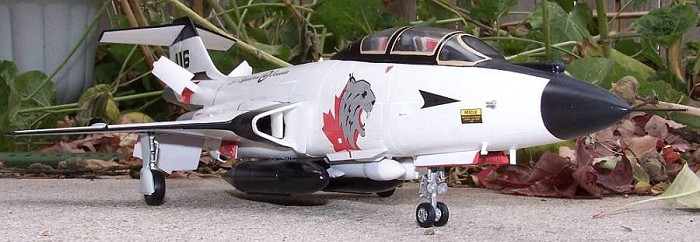
Monogram 1/48 F-101B Voodoo
| KIT #: | 5289 |
| PRICE: | $9.95 MSRP at the time it was new. |
| DECALS: | One option |
| REVIEWER: | Dimitriy Levin |
| NOTES: | Century Series Boxing |

| HISTORY |
The mighty F-101 Voodoo, the “One-oh-wonder” needs little introduction. It was designed as a long-range escort fighter with engines cleverly tucked under the fuselage to make room for a whopping 2,340 gallons of internal fuel (3,467 gallons if external tanks are your thing) giving it a 1,900 mile combat radius or a 2,925 mile ferry range. Voodoo was the first aircraft in USAF inventory capable of exceeding 1,000 mph in level flight and on December 12, 1957, F-101A set a world speed record of 1,207 mph handily beating the previous record-holder Fairey Delta FD.2 by over 70 mph.
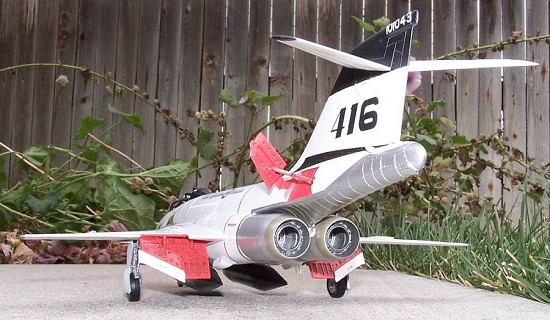 When
Strategic Air Command lost interest in the escort fighter concept because,
like B-17 before it, the new B-52 would be impossible to intercept, the
F-101 got a second life as a tactical reconnaissance platform and the
interceptor. Carrying “two meanies and two Genies” (as well as less
complimentary “50,000 pounds of &^*#”) the F-101B formed the backbone of
Air Defense Command from 1959 to 1972, with the last aircraft retiring from
Air National Guard in 1982. It also enjoyed a long career with Royal
Canadian Armed Forces where it replaced the cancelled CF-105 Arrow. In
spite of its heft, F-101B propelled by the larger J57-P-55 turbojets
sported an initial climb rate of almost 50,000 feet/minute (a feat then
exceeded only by the mighty F-4 Phantom and the slick F-104 Starfighter)
and topped out at 1,134 mph (Mach 1.72) at 35,000 feet in spite of not
having the aerodynamic advantage of Whitcomb’s area rule.
When
Strategic Air Command lost interest in the escort fighter concept because,
like B-17 before it, the new B-52 would be impossible to intercept, the
F-101 got a second life as a tactical reconnaissance platform and the
interceptor. Carrying “two meanies and two Genies” (as well as less
complimentary “50,000 pounds of &^*#”) the F-101B formed the backbone of
Air Defense Command from 1959 to 1972, with the last aircraft retiring from
Air National Guard in 1982. It also enjoyed a long career with Royal
Canadian Armed Forces where it replaced the cancelled CF-105 Arrow. In
spite of its heft, F-101B propelled by the larger J57-P-55 turbojets
sported an initial climb rate of almost 50,000 feet/minute (a feat then
exceeded only by the mighty F-4 Phantom and the slick F-104 Starfighter)
and topped out at 1,134 mph (Mach 1.72) at 35,000 feet in spite of not
having the aerodynamic advantage of Whitcomb’s area rule.
Armament initially consisted of four AIM-4 Falcon missiles mounted on both sides of a flat rotating weapons bay. In 1961, the oddly named Project Kitty Car upgraded most aircraft to carry AIR-2 Genie rockets instead of two Falcons. The unguided Genies sported a Mach 3.3 top speed and the hefty punch of a 1.5 kiloton nuclear warhead with a lethal radius of 1,000 feet. The F-101 was expected to briskly reverse the direction of flight after launching the missiles in order to avoid the blast with launch and escape accomplished automatically by the MG-13 fire control system. The only firing of a nuclear Genie took place on July 19, 1957, as the John Shot of Operation Plumbbob.
In spite of excellent performance and a good safety record, F-101B was not without its problems. Throughout its service life, the aircraft was plagued by a severe pitch-up resulting in the aircraft swapping ends. This was caused by stalling of the stabilators at high angles of attack as they entered the wake created by the wings. Deploying the braking parachute often but not always helped to regain control of the aircraft.
| THE KIT |
The venerable Monogram kit dates back to the company’s golden age in the 1980’s. My copy was in the new “Century Series” boxing depicting two RCAF Voodoos in the special Lynx Squadron scheme. On opening the box, one is greeted by about a 100 parts molded in white styrene with finely raised panel lines. The molding is exceptionally clean with no flash and no mold misalignment seams. The avionics bay scoop had a small sink mark.
Instructions are the usual Monogram fare with 32 construction steps. Color callouts during construction are generic names, but the painting instructions give FS numbers (any color you like as long as it’s ADC Gray). Although the instructions show marking schemes for a 60th FIS aircraft and the Lynx, the box only contained the Canadian decals. Whether this is intentional (given the image on the box) or the result of the “thar be monsters” of eBay is unknown to me.
| CONSTRUCTION |
Before I dive into construction here are a few general observations about the kit
- General shape is very good with no obvious flaws.
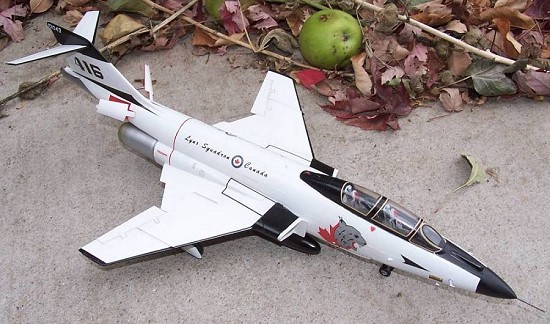 -
Cockpit is superb, again without obvious flaws. There is scale-appropriate
simplification in places like cables to the prominent rear radar scope.
-
Cockpit is superb, again without obvious flaws. There is scale-appropriate
simplification in places like cables to the prominent rear radar scope.
- Landing gear bays are again very well done. Some of the finer mechanisms are simplified to scale. The retraction links for inboard main landing gear doors are absent.
- The model is very likely based on a museum aircraft. Main landing gear struts are almost completely collapsed with main gear doors molded as a single piece. The real doors are two pieces horizontally split where the wheel bulge begins. There are retraction locks molded onto the main gear retraction links and airbrake actuators. The instructions even tell you to paint these red.
- Engine intakes are simplified. In addition, the cone in front of the compressor faces is absolutely wrong. It is represented as a symmetrical rounded bulb while the real thing is a complex three-dimensional shape and much more pointed. I recommend leaving the intakes “as is” as these details are not obvious on the finished model or making covers.
- To my mind, the biggest problem with the kit are the Falcon missiles. Included are two AIM-4G Super Falcons which were only used on the F-106 (in fact, they are probably too big to even fit on the F-101B) and this is far more obvious than intakes or other minor details. The easiest solution is to take AIM-4D’s from Monogram’s own F-102A kit or to build the model Genies down. If you are going to install the Falcons, you should add the launch rails which retracted into the grooves to the outside of the missiles.
 Construction begins with the cockpit. This is exceptionally well done with
no need for aftermarket at all. I hand-painted everything with PollyScale
acrylics and highlighted raised details with a Prismacolor silver pencil.
Of note, the rudder pedals are too far forward. If you are planning to sit
the “meanies” in the airplane, these should be detached and moved further
in. A separate hood is provided for the rear radar scope and while the kit
instructs you to stow it at the back of the canopy, I installed mine to
avoid dealing with representation of the prominent radar screen.
Impressively, it fit perfectly.
Construction begins with the cockpit. This is exceptionally well done with
no need for aftermarket at all. I hand-painted everything with PollyScale
acrylics and highlighted raised details with a Prismacolor silver pencil.
Of note, the rudder pedals are too far forward. If you are planning to sit
the “meanies” in the airplane, these should be detached and moved further
in. A separate hood is provided for the rear radar scope and while the kit
instructs you to stow it at the back of the canopy, I installed mine to
avoid dealing with representation of the prominent radar screen.
Impressively, it fit perfectly.
Nose and landing gear bays are also bristling with detail. As noted above, intake trunking is iffy but a full length leading to the engine faces is provided. The trunks do not fit particularly well but the resultant seams are not obvious and, to my (non-competition) mind not worth the extreme difficulty of eliminating them. In an odd bit of kit engineering, inboard main gear doors are provided as one piece with the inner wheel well bulkhead. I recommend detaching them to ease painting – I didn’t and it was a hassle later on. The same applies to the nose gear doors although I suspect that removing them would make it very difficult to properly align the nose wheel well assembly. Swap steps 14 and 15 and install door retraction links before bringing together the left and right halves of the nose wheel well. The rotating weapons bay is a tight fit and since I was building my model Genies down (not wanting to rob the Deuce in my stash) I simply glued it in place. Otherwise, it’s a rather tricky assembly. Don’t forget to install a blanking plate in the tail before closing the fuselage – I’m not sure why Monogram made a see-through hole under the stabilators but it is not supposed to be liked that. No nose weight is needed for this aircraft.
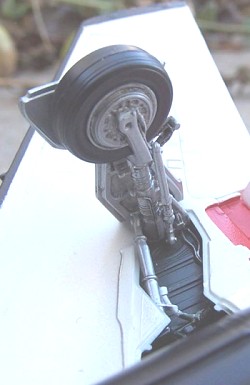 Overall fit is decent (typical for Monogram jets). The biggest problem
area is top of the wing to fuselage join. The gap is rather large and the
joint is very weak. To deal with this, I filled the gap with stretched
sprue and plenty of Tenax. The (heavy!) model survived plenty of handling
by the wings without problems. The nose cone and the fences on either side
of the weapons bay do not fit well – don’t leave them off until after
painting! The afterburner shrouds are supposed to have a longitudinal seam
where the two halves are joined but there was some misalignment between the
halves and the last exhaust section made doubly unsightly because of the
metallic finish so I ended up sanding the parts smooth. The transverse
encircling lines are supposed to represent very fine continuous spot welds
for internal structural ribs. The armadillo look of the underside of the
tail is captured remarkably well in the model. Stabilators can be left off
until the very end for ease of painting.
Overall fit is decent (typical for Monogram jets). The biggest problem
area is top of the wing to fuselage join. The gap is rather large and the
joint is very weak. To deal with this, I filled the gap with stretched
sprue and plenty of Tenax. The (heavy!) model survived plenty of handling
by the wings without problems. The nose cone and the fences on either side
of the weapons bay do not fit well – don’t leave them off until after
painting! The afterburner shrouds are supposed to have a longitudinal seam
where the two halves are joined but there was some misalignment between the
halves and the last exhaust section made doubly unsightly because of the
metallic finish so I ended up sanding the parts smooth. The transverse
encircling lines are supposed to represent very fine continuous spot welds
for internal structural ribs. The armadillo look of the underside of the
tail is captured remarkably well in the model. Stabilators can be left off
until the very end for ease of painting.
As I mentioned, I was building my kit Genies down. These fit well and have good detail. The droptanks were installed to add some contrast to the otherwise monochromic model. These did not fit well because their mounting holes in the fuselage are much larger than the pins on the tanks. Be sure to follow instructions for correct alignment of the tanks. Nose landing gear can be tricky to fit into the narrow bay if you leave it off until the end. Main landing gear attachment is VERY weak – it’s simply a butt joint against the top of the wing with retraction linkages providing only minimal support. I wish Monogram would have sacrificed some accuracy for a pin-and-groove attachment instead. As it is, you end up with a very heavy model that absolutely cannot tolerate any side-to-side movement. A way of dealing with this may be to run a pin through the landing gear and through the wing although not much wing thickness is available. Another way, and something I will likely do if the gear breaks again, is to sand down the top of the gear until the L-shaped portion of the main gear doors rests on the wing and using that for support.
My only deviations from an OOB build were hollowing out the fuel dump vents (sharp spikes on either side of the tail), avionics bay cooling scoop in the nose, and the engine/afterburner cooling scoops under the rear fuselage. In addition, I replaced the kit spotlight on the port side of the cockpit with a piece of round clear sprue, and I sanded off the slime lights which were not present on Canadian aircraft. A note on the scoops – most Canadian Voodoos had a NACA-style recessed scoop for the avionics bay. The recess in the fuselage for the protruding scoop can be easily shaped for that purpose. I left an external scoop on my model because I have photos of RCAF Voodoos with these and (mainly) because it was late in the construction and I was getting lazy.
Clear parts are transparent with nicely done framing and very good fit. If you want to make the open canopy, be careful about placing the rear bulkhead in the clear part. I installed mine according to instructions and it ended up interfering with the rear ejection seat forcing me to resort to the removable canopy instead.
| COLORS & MARKINGS |
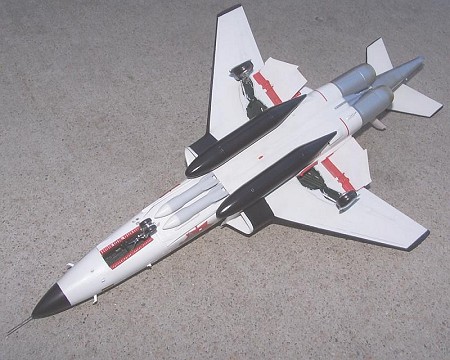 I chose
to represent a CF-101 in the 416th “Lynx” Squadron special
scheme commemorating retirement of the Voodoo from RCAF. The airframe was
painted PollyScale white and PollyScale night black with wheel wells in
PollyScale RAF dark green (a surprisingly close match to the real
aircraft). Landing gear is PollyScale ATSF Silver and the afterburners and
the underside of the tail are Gunze Aqueous Silver accented with
ModelMaster Jet Exhaust. Red is a PollyScale Luftwaffe color. Seals
around canopy framing are PollyScale light tan – this is a much better
match than the yellow indicated in the instructions. Kit decals worked
exceptionally well. The large lynx logos required a small amount of
Microsol to settle down.
I chose
to represent a CF-101 in the 416th “Lynx” Squadron special
scheme commemorating retirement of the Voodoo from RCAF. The airframe was
painted PollyScale white and PollyScale night black with wheel wells in
PollyScale RAF dark green (a surprisingly close match to the real
aircraft). Landing gear is PollyScale ATSF Silver and the afterburners and
the underside of the tail are Gunze Aqueous Silver accented with
ModelMaster Jet Exhaust. Red is a PollyScale Luftwaffe color. Seals
around canopy framing are PollyScale light tan – this is a much better
match than the yellow indicated in the instructions. Kit decals worked
exceptionally well. The large lynx logos required a small amount of
Microsol to settle down.
| CONCLUSIONS |
There you have it, a big bad Voodoo. The kit goes together reasonably well and rewards the builder with plenty of detail straight from the box. Modelers acquainted with anything beyond the modern shake-and-bake kits would have no trouble working their magic on this one.
| REFERENCES |
1. Wikipedia. http://en.wikipedia.org/wiki/F-101_Voodoo
2. Joe Baugher’s website. http://home.att.net/~jbaugher1/f101_3.html
3. http://www.airliners.net for photos of the real Lynx scheme.
4. F-101B 58-0271 at Wings Over the Rockies Air and Space Museum. http://www.wingsmuseum.org
Dimitriy Levin
December 2005
Copyright ModelingMadness.com. All rights reserved. No reproduction in part or in whole without express permission.
If you would like your product reviewed fairly and fairly quickly, please contact the editor or see other details in the Note to Contributors.